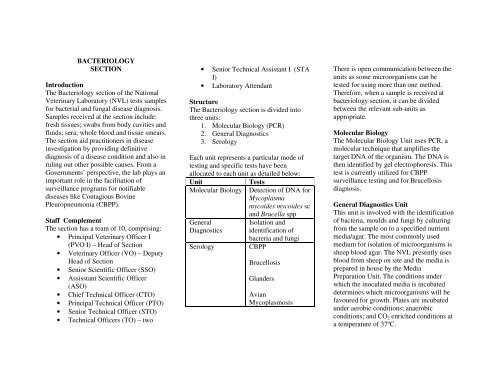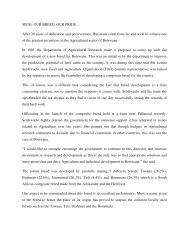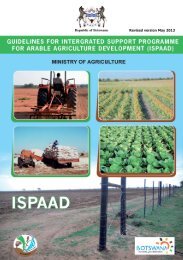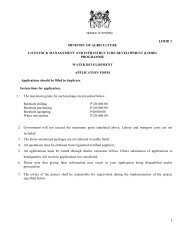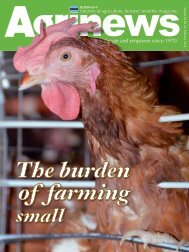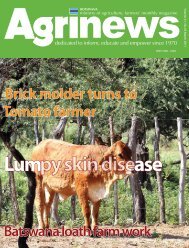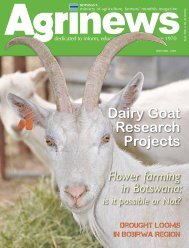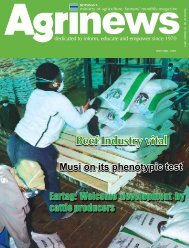Service provided by Bacteriology Section
Service provided by Bacteriology Section
Service provided by Bacteriology Section
You also want an ePaper? Increase the reach of your titles
YUMPU automatically turns print PDFs into web optimized ePapers that Google loves.
BACTERIOLOGYSECTIONIntroductionThe <strong>Bacteriology</strong> section of the NationalVeterinary Laboratory (NVL) tests samplesfor bacterial and fungal disease diagnosis.Samples received at the section include:fresh tissues; swabs from body cavities andfluids; sera; whole blood and tissue smears.The section aid practitioners in diseaseinvestigation <strong>by</strong> providing definitivediagnosis of a disease condition and also inruling out other possible causes. From aGovernments’ perspective, the lab plays animportant role in the facilitation ofsurveillance programs for notifiablediseases like Contagious BovinePleuropneumonia (CBPP).Staff ComplementThe section has a team of 10, comprising:• Principal Veterinary Officer I(PVO I) – Head of <strong>Section</strong>• Veterinary Officer (VO) – DeputyHead of <strong>Section</strong>• Senior Scientific Officer (SSO)• Assisstant Scientific Officer(ASO)• Chief Technical Officer (CTO)• Principal Technical Officer (PTO)• Senior Technical Officer (STO)• Technical Officers (TO) – two• Senior Technical Assistant I (STAI)• Laboratory AttendantStructureThe <strong>Bacteriology</strong> section is divided intothree units:1. Molecular Biology (PCR)2. General Diagnostics3. SerologyEach unit represents a particular mode oftesting and specific tests have beenallocated to each unit as detailed below:UnitMolecular BiologyGeneralDiagnosticsSerologyTestsDetection of DNA forMycoplasmamycoides mycoides scand Brucella sppIsolation andidentification ofbacteria and fungiCBPPBrucellosisGlandersAvianMycoplasmosisThere is open communication between theunits as some microorganisms can betested for using more than one method.Therefore, when a sample is received atbacteriology section, it can be dividedbetween the relevant sub-units asappropriate.Molecular BiologyThe Molecular Biology Unit uses PCR, amolecular technique that amplifies thetarget DNA of the organism. The DNA isthen identified <strong>by</strong> gel electrophoresis. Thistest is currently utilized for CBPPsurveillance testing and for Brucellosisdiagnosis.General Diagnostics UnitThis unit is involved with the identificationof bacteria, moulds and fungi <strong>by</strong> culturingfrom the sample on to a specified nutrientmedia/agar. The most commonly usedmedium for isolation of microorganisms issheep blood agar. The NVL presently usesblood from sheep on site and the media isprepared in house <strong>by</strong> the MediaPreparation Unit. The conditions underwhich the inoculated media is incubateddetermines which microorganisms will befavoured for growth. Plates are incubatedunder aerobic conditions; anaerobicconditions; and CO 2 enriched conditions ata temperature of 37ºC.
Additional tests which are necessary in theidentification of bacteria are: the Gramstain, catalase, oxidase, oxidativefermentativeand biochemical sugars testsamong others. These procedures are alldiligently performed <strong>by</strong> the analysts in theGeneral Diagnostics unit.Other diagnostic techniques employed inthe unit include microscopy, mouseinoculation tests and FAT. For certainbacteria, such as Bacillus anthracis, withunique identifying features theirmorphology can be readily confirmedunder the microscope.Diseases tested for are those caused <strong>by</strong>infectious agents of Bacterial origin suchas;• Pasteurellosis• Enterotoxaemia• Anthax• Back quarter• Salmonellosis• Collibacillosis• Campylobacteriosis•• Ringworm• Other Fungal diseasesFig.1 Analyst preparing a plate for cultureSerology UnitThe test complement for Serology unit ismade up of:• Complement Fixation Test (CFT)and culture for CBPP• Rose Bengal Plate Test (RBPT)and CFT for Brucellosis• CFT for Glanders was recentlyintroduced• ELISA and culture for AvianMycoplasmasFig.2 Analyst performing a serological testA particularly exciting development for theserology unit in the past year has been thegaining of an accreditation to ISO 17025standard <strong>by</strong> the South African NationalAccreditation Scheme (SANAS) for theCFT for CBPP. It effectively guaranteesthe quality of results produced and placesthe NVL in a good position in its bid tobecome the regional reference laboratoryfor CBPP testing.


